Squat toilet
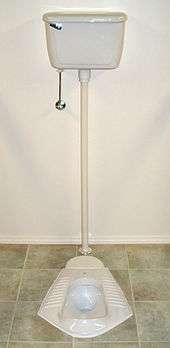
A squat toilet (also known as a squatting toilet, Indian toilet, or Turkish toilet) is a toilet used by squatting, rather than sitting. There are several types of squat toilets, but they all consist essentially of toilet pan or bowl at floor level. Such a toilet pan is also called a "squatting pan". The only exception is a "pedestal" squat toilet, which is of the same height as a sitting toilet. It is in theory also possible to squat over sitting toilets, but this requires extra care to prevent accidents as they are not designed for squatting.
A squat toilet may use a water seal and therefore be a flush toilet, or it can be without a water seal and therefore be a dry toilet. The term "squat" only refers to the expected defecation posture and not any other aspects of toilet technology, such as whether it is water flushed or not.
Squat toilets are used all over the world, but are particularly common in many Asian and African countries and those with a large proportion of people of Muslim or Hindu faith who also practise anal cleansing with water.
Terminology
Squat toilets are fixed in-ground commodes which require the individual to squat on bent knees.[1] In contrast to a pedestal or a sitting toilet the opening level is located with the ground. Squat toilets are sometimes called "eastern style toilets" because they can be found in various countries including Japan, China, India and the Middle East.[2] Conversely, sitting toilets are often referred to as "western style toilets".[3]
Design considerations
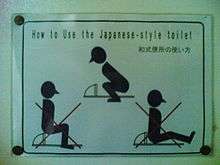
Squatting slabs can be made of porcelain (ceramic), stainless steel, fibreglass, or in the case of low-cost versions in developing countries, with concrete, ferrocement, plastic, or wood covered with linoleum.[4][5] Slabs can also be made of wood (timber), but need to be treated with preservatives, such as paint or linoleum, to prevent rotting and to enable thorough cleaning of the squatting slab.[5]
Maintenance
The standing surface of the squatting pan should be kept clean and dry in order to prevent disease transmission and to limit odors.[4]
Squat toilets are usually easier to clean than sitting toilets (pedestals), except that one has to bend down further if the squatting pan needs manual scrubbing. They can be cleaned by using a mop and hose, together with the rest of the floor space in the toilet room or cubicle.
Cultural preferences by region
Much of the world's population use squat toilets, especially in rural areas.
- Squat toilets are common in many Asian countries,[6] including Japan[7] and Thailand.[8] They are also common in India, China, North Korea, South Korea, Singapore, Myanmar, Iran and Taiwan.[9]
- People in sub-Saharan countries, especially in rural areas, for example in Kenya, Rwanda, Somalia, Tanzania, and Uganda, use squat toilets as well.[10]
- Countries in the Middle East and in Northern Africa seem to often have both types of toilets, sitting and squatting.
- In Southern and Eastern Europe including parts of France, Greece, Italy, Balkans, and Russia they are common, especially in public restrooms.[11]
- In Muslim or Hindu cultures the prevalence of squat toilets is generally quite high, as is the practice of anal cleansing with water.[10]
People in places like Australia, New Zealand, and Northern and Western Europe generally do not use squat toilets.[10] In Germany squat toilets have not been used, but in France they were the norm throughout the early 20th century.[3]
Sitting or squatting can also depend on the toilet type: In Latin and South America flush toilets are always of the sitting type, whereas dry toilets may be either of the sitting or a squatting type. The occurrence of squat toilets in urban areas of Latin America appears to be rather low.
China
The majority of urban residents in China prefer traditional squat toilets over sitting toilets, especially in public places.[12] Nevertheless, sitting toilets have become the norm in Shanghai and they are increasingly used in Beijing.[12] Sitting toilets are on the one hand associated with development and modernization, and on the other hand with disease.[12]
Japan
Since the 1980s high-tech sitting toilets are emerging that replace traditional squat toilets, especially in urban areas. One of those toilets with the brand name "Washlet" eliminates the need for toilet paper through a "posterior wash" and features heated toilet seats. However, many rural people have no experience with such high-tech toilets and need detailed instructions.[13]
Perceptions and trends
Some people regard squat toilets as more hygienic compared to sitting toilets because they are easier to clean and there is no skin contact with the surface of the toilet seat,[10] and squat toilets are therefore more common in public places than in households in some countries. On the other hand, sitting toilets are perceived by many people to be more modern, therefore they can represent a certain status. Additionally, sitting toilets are more convenient for people with disabilities.
A trend towards more sitting toilets in countries that were traditionally using squat toilets can be observed in some urban and more affluent areas, in areas with new buildings (as well as hotels and airports) or in tourist regions.[10]
Gallery
 Squat toilet at a motorway service station near Toulouse, France
Squat toilet at a motorway service station near Toulouse, France.jpg) Typical toilet in urban Syria: Flush toilet squatting pan with hose on the left for anal cleansing.
Typical toilet in urban Syria: Flush toilet squatting pan with hose on the left for anal cleansing.- Public squat toilet in Tsarskoe Selo, Russia
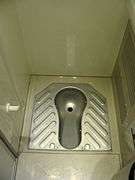 Squat toilet in a high-speed train on the Guangshen Line in China
Squat toilet in a high-speed train on the Guangshen Line in China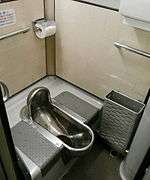 Squat toilet aboard a Japanese Ginga train
Squat toilet aboard a Japanese Ginga train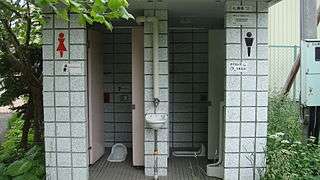 Public toilet at Jozankei Hot Springs, Hokkaido, Japan
Public toilet at Jozankei Hot Springs, Hokkaido, Japan
See also
References
- ↑ Burns, Anthony S.; O'Connell, Colleen (2012): The challenge of spinal cord injury care in the developing world. The Journal of Spinal Cord Medicine 35 (1): 3–8.
- ↑ Mulholland, S. J.; Wyss, U. P. (2001): Activities of daily living in non-Western cultures: range of motion requirements for hip and knee joint implants. International journal of rehabilitation research 24 (3): 191–198.
- 1 2 Gershenson, Olga; Penner, Barbara (2009): Ladies and gents - Public toilets and gender. Temple University Press, Philadelphia, Pennsylvania.
- 1 2 Tilley, E.; Ulrich, L.; Lüthi, C.; Reymond, Ph.; Zurbrügg, C. (2014): Compendium of Sanitation Systems and Technologies - (2nd Revised Edition). Swiss Federal Institute of Aquatic Science and Technology (Eawag), Duebendorf, Switzerland: 44. ISBN 978-3-906484-57-0. Retrieved 31. August 2015
- 1 2 Reed, Brian; Shaw, Rod (2011). G005: Latrine slabs - an engineer's guide. Loughborough, UK: WEDC. p. 11. ISBN 9781843801436. Retrieved 8 April 2015.
- ↑ Lechner, Norbert (2012): Plumbing, Electricity, Acoustics - Sustainable Design Methods for Architecture. John Wiley & Sons, Hoboken, New Jersey.
- ↑ Fujita, Takuo (1994): Osteoporosis in Japan: Factors Contributing to the Low Incidence of Hip Fracture. In: Advances in Nutritional Research, Vol. 9: 89–99.
- ↑ Lonely Planet Southeast Asia on a Shoestring. Lonely Planet. 2014. ISBN 9781742207537.
- ↑ Chang, Jin-Soo (2014): The Cultural and Environmental Unsoundness of the Chinese Public Squatting-Type Toilet: A Case Study toward a Sustainable Excreta Treatment System. Environmental Engineering Research 19 (2): 131–138.
- 1 2 3 4 5 von Münch, E.; Milosevic, D. (2015): Qualitative survey on squatting toilets and anal cleansing with water with a special emphasis on Muslim and Buddhist countries by using the SuSanA discussion forum. Ostella Consulting, Schwalbach, Germany
- ↑ Olmert, Carol (2008): Bathrooms make me nervous. A guidebook for women with urination anxiety (shy bladder). CJOB Publications, Walnut Creek, California: 61.
- 1 2 3 Tobin, Joseph; Hsueh, Yeh; Karasawa, Mayumi (2009): Preschool in Three Cultures Revisited: China, Japan, and the United States. University of Chicago Press, Chicago, Illinois.
- ↑ Cavusgil, S. Tamer; Rammal, Hussain; Freeman, Susan (2012): International Business: The New Realities. Pearson, Australia
External links
| Wikimedia Commons has media related to Squat toilets. |